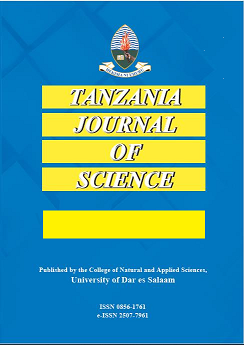Impact of Zn and W Doping Levels on Properties of Thermochromic VO2-Based Thin Films
DOI:
https://doi.org/10.4314/tjs.v49i4.3Keywords:
W/Zn co-doping, Vanadium dioxide, Co-sputtering, Smart windowsAbstract
DC magnetron sputtering at a substrate temperature of 425 °C was used to successfully deposit W/Zn-doped VO2 thin films on soda lime glass (SLG) substrates. The aim was to investigate the influence of Zn doping levels on the transition temperature ( ), luminous transmittance (Tlum) and solar transmittance modulation (ΔTsol) of VO2-based thin films. UV/VIS/NIR spectrometer, X-ray Diffraction (XRD), Atomic Force Microscope (AFM), and Rutherford Backscattering Spectroscopy (RBS) were used to characterise the thin films. It was revealed that W/Zn co-doped VO2 thin films with ~ 10.8 at.% Zn showed a luminous transmittance of ~ 40.4%, with excellent solar transmittance modulation of 10.2%. Furthermore, the transition temperature obtained for the Zn and W co-doped VO2 films with ~ 10.8 at.% Zn was lower at 23.1 °C compared to 25.6 °C and 26.8 °C for thin films with ~ 3.9 at.% Zn and ~ 2.8 at.% Zn, respectively. It was not possible to deposit the films with Zn doping level above 10.8 at.% due to some technical limitations. These findings indicate that thin films with a controlled proportion of Zn in the W/Zn co-doped VO2-based thin films have the potential to be employed for applications such as smart windows.


